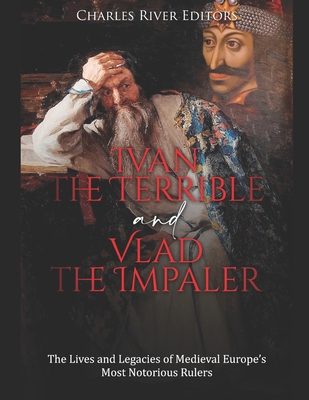Ivan the Terrible and Vlad the Impaler: The Lives and Legacies of Medieval Europe's Most Notorious Rulers

Ivan the Terrible and Vlad the Impaler: The Lives and Legacies of Medieval Europe's Most Notorious Rulers
*Includes pictures
*Includes a bibliography for further reading
Many medieval figures are somewhat shrouded in mystery, due to the scarcity of available sources and to the difficulties posed by the interpretation of historical narratives dating from this period. And even when there is enough documented evidence to put together a sufficiently coherent biographical account, other sources and accounts may emerge that flagrantly contradict the already established and generally accepted historical narrative.
Nowhere is this more evident than in the legacy of Vlad III Dracula, who history has recorded as one of the most notorious and bloodthirsty tyrants of the 15th century. In addition to lending the name Dracula to Bram Stoker's famous vampire, Vlad is known around the world by the cognomen Vlad the Impaler, due to his reputation for impaling thousands of his enemies. Vlad was reputed to be such a tyrant that his reputation and stories of his deeds spread across Germany and the rest of Europe during his lifetime.
However, two very conflicting images emerge when contemporary narratives and chronicles are considered. On the one hand, he is portrayed by a variety of sources as a blood-thirsty tyrant with a penchant for devising unnecessarily cruel punishments. But on the other hand, he appears as a heroic and brave fighter against the Ottoman Empire's ongoing threat towards Wallachian territorial integrity and autonomy. There are probably grains of truth to both depictions; Vlad did indeed implement an authoritarian internal policy in order to increase his power within the state, while also attempting to defend Wallachian independence in the face of both Hungarian and Ottoman encroachments. The accounts, however, are divergent in almost every other respect, including the specific character of his punishments and the motivations outlining them, the number of victims, and, most significantly, the personality of the ruler himself.
16th century Russia remains, for most Western audiences, a dark and terrifying space, wrapped in mystery and myth and isolated from states such as England or France, whose heroes are well-known throughout Europe. The traditional dichotomy between East and West is most apparent in the discussion of the remarkable political figures that defined this century. While Western rulers, such as Elizabeth I, Francis I or Charles V, Holy Roman Emperor, have been endlessly and almost exhaustively treated in historical works, their
PRP: 95.48 Lei
Acesta este Pretul Recomandat de Producator. Pretul de vanzare al produsului este afisat mai jos.
85.93Lei
85.93Lei
95.48 LeiLivrare in 2-4 saptamani
Descrierea produsului
*Includes pictures
*Includes a bibliography for further reading
Many medieval figures are somewhat shrouded in mystery, due to the scarcity of available sources and to the difficulties posed by the interpretation of historical narratives dating from this period. And even when there is enough documented evidence to put together a sufficiently coherent biographical account, other sources and accounts may emerge that flagrantly contradict the already established and generally accepted historical narrative.
Nowhere is this more evident than in the legacy of Vlad III Dracula, who history has recorded as one of the most notorious and bloodthirsty tyrants of the 15th century. In addition to lending the name Dracula to Bram Stoker's famous vampire, Vlad is known around the world by the cognomen Vlad the Impaler, due to his reputation for impaling thousands of his enemies. Vlad was reputed to be such a tyrant that his reputation and stories of his deeds spread across Germany and the rest of Europe during his lifetime.
However, two very conflicting images emerge when contemporary narratives and chronicles are considered. On the one hand, he is portrayed by a variety of sources as a blood-thirsty tyrant with a penchant for devising unnecessarily cruel punishments. But on the other hand, he appears as a heroic and brave fighter against the Ottoman Empire's ongoing threat towards Wallachian territorial integrity and autonomy. There are probably grains of truth to both depictions; Vlad did indeed implement an authoritarian internal policy in order to increase his power within the state, while also attempting to defend Wallachian independence in the face of both Hungarian and Ottoman encroachments. The accounts, however, are divergent in almost every other respect, including the specific character of his punishments and the motivations outlining them, the number of victims, and, most significantly, the personality of the ruler himself.
16th century Russia remains, for most Western audiences, a dark and terrifying space, wrapped in mystery and myth and isolated from states such as England or France, whose heroes are well-known throughout Europe. The traditional dichotomy between East and West is most apparent in the discussion of the remarkable political figures that defined this century. While Western rulers, such as Elizabeth I, Francis I or Charles V, Holy Roman Emperor, have been endlessly and almost exhaustively treated in historical works, their
Detaliile produsului








